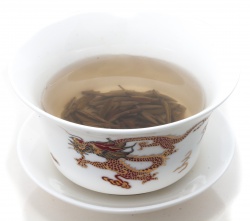Difference between revisions of "Gaiwan"
| Line 6: | Line 6: | ||
==Function== | ==Function== | ||
| − | [[File: | + | [[File:Gaiwan-red-dragon-open.jpg|right|thumb|250px|Gaiwan with open lid]] |
| − | |||
The gaiwan is considered by many tea connoisseurs to be the preferred method for brewing teas with delicate flavors and aromas, such as [[green tea]] and [[white tea]], although without the lid in these cases. The versatility of the gaiwan is also noted in the preparation of [[oolong]] infusions because of this particular tea's ability to be infused multiple times, but the gaiwan is suitable for any type of tea. The gaiwan is important in tea tasting due to its open and glazed surfaces: the former allows the tea to be viewed while brewing, and the latter prevents altering of the flavour and aroma of the tea during brewing. | The gaiwan is considered by many tea connoisseurs to be the preferred method for brewing teas with delicate flavors and aromas, such as [[green tea]] and [[white tea]], although without the lid in these cases. The versatility of the gaiwan is also noted in the preparation of [[oolong]] infusions because of this particular tea's ability to be infused multiple times, but the gaiwan is suitable for any type of tea. The gaiwan is important in tea tasting due to its open and glazed surfaces: the former allows the tea to be viewed while brewing, and the latter prevents altering of the flavour and aroma of the tea during brewing. | ||
| − | The gaiwan consists of a saucer, bowl, and lid. The lid allows the tea to be infused right in the bowl and either be drunk right from the bowl (traditionally using the lid to block the leaves for ease of consumption), or decanted into another container. The gaiwan itself can be made from a variety of materials, including | + | The gaiwan consists of a saucer, bowl, and lid. The lid allows the tea to be infused right in the bowl and either be drunk right from the bowl (traditionally using the lid to block the leaves for ease of consumption), or decanted into another container. The gaiwan itself can be made from a variety of materials, including porcelain and glass. Gaiwans made from [[Yixing clay]] or jade are particularly prized by collectors of tea paraphernalia. |
Gaiwan is the preferred method for brewing green and white teas as the gaiwan's porcelain absorbs the heat and does not damage the tea. Gaiwans are less suitable for black teas as the large lid allows heat to escape too quickly during the steeping process. They are especially common in the north of China for enjoying scented teas like jasmine tea. | Gaiwan is the preferred method for brewing green and white teas as the gaiwan's porcelain absorbs the heat and does not damage the tea. Gaiwans are less suitable for black teas as the large lid allows heat to escape too quickly during the steeping process. They are especially common in the north of China for enjoying scented teas like jasmine tea. | ||
Revision as of 08:26, 8 June 2013
Gaiwan (盖碗) is a Chinese tea cup with lid which is used for making tea. Because of its functionality, elegant simplicity and ease of handling, the Gaiwan is a universal tool in the preparation of tea.
History

Prior to the Ming Dynasty (1368–1644), tea was normally consumed from the vessel in which it was prepared. As described by the tea master Lu Yu, this special bowl had to be large enough to accommodate the implements and actions of tea brewing, though compact enough to be held comfortably in the hands for consumption. The term for this versatile piece of equipment was chawan (茶碗; lit. "tea bowl"). It was during the Ming Dynasty that the innovations in both tea ritual and tea preparation gave rise to the gaiwan. The gaiwan of today are generally smaller and more leaves are used in brewing.
Function
The gaiwan is considered by many tea connoisseurs to be the preferred method for brewing teas with delicate flavors and aromas, such as green tea and white tea, although without the lid in these cases. The versatility of the gaiwan is also noted in the preparation of oolong infusions because of this particular tea's ability to be infused multiple times, but the gaiwan is suitable for any type of tea. The gaiwan is important in tea tasting due to its open and glazed surfaces: the former allows the tea to be viewed while brewing, and the latter prevents altering of the flavour and aroma of the tea during brewing. The gaiwan consists of a saucer, bowl, and lid. The lid allows the tea to be infused right in the bowl and either be drunk right from the bowl (traditionally using the lid to block the leaves for ease of consumption), or decanted into another container. The gaiwan itself can be made from a variety of materials, including porcelain and glass. Gaiwans made from Yixing clay or jade are particularly prized by collectors of tea paraphernalia.
Gaiwan is the preferred method for brewing green and white teas as the gaiwan's porcelain absorbs the heat and does not damage the tea. Gaiwans are less suitable for black teas as the large lid allows heat to escape too quickly during the steeping process. They are especially common in the north of China for enjoying scented teas like jasmine tea.
Use
Usually all three parts are held at once with both hands. The saucer is held with the fingers of the right hand while the thumb rests on the edge of the bowl. The left hand then holds the lid, which is used to brush away the tea leaves before drinking. It can take some practice to do this, as the liquid tends to be hot.
